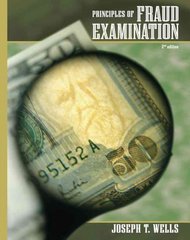Question
Common stock ($5 par value; 47,000 shares outstanding) Preferred stock, 10% ($10 par value; 9,400 shares outstanding) Retained earnings $235,000 94,000 288,000 The board of
Common stock ($5 par value; 47,000 shares outstanding) Preferred stock, 10% ($10 par value; 9,400 shares outstanding) Retained earnings $235,000 94,000 288,000 The board of directors is considering the distribution of a cash dividend to the two groups of stockholders. No dividends were declared during the previous two years. Assume the three cases below are independent of each other. Case A: The preferred stock is noncumulative; the total amount of all dividends is $38,000. Case B: The preferred stock is cumulative; the total amount of all dividends is $28,200. Case C: The preferred stock is cumulative; the total amount of all dividends is $91,400. Required: 1. Compute the amount of dividends, in total and per share, that would be payable to each class of stockholders for each case. (Round "Dividends per Share" to 2 decimal places.) Complete this question by entering your answers in the tabs below. Required 1 Required 2 Compute the amount of dividends, in total and per share, that would be payable to each class of stockholders for each case. (Round "Dividends per Share" to 2 decimal places.) Preferred Dividends Common Dividends per Share Total Preferred Common Case A $ 9,400 $28,600 $ 38,000 Case B $ 28,200 $ 28,200 Case C $ 28,200 $ 63,200 $ 91,400 Chicago Company reported the following information at the end of the current year: Common stock ($5 par value; 47,000 shares outstanding) Preferred stock, 10% ($10 par value; 9,400 shares outstanding) Retained earnings $235,000 94,000 288,000. The board of directors is considering the distribution of a cash dividend to the two groups of stockholders. No dividends were declared during the previous two years. Assume the three cases below are independent of each other. Case A: The preferred stock is noncumulative; the total amount of all dividends is $38,000. Case B: The preferred stock is cumulative; the total amount of all dividends is $28,200. Case C: The preferred stock is cumulative; the total amount of all dividends is $91,400. Required: 1. Compute the amount of dividends, in total and per share, that would be payable to each class of stockholders for each case. (Round "Dividends per Share" to 2 decimal places.) Complete this question by entering your answers in the tabs below. Required 1 Required 2 Assume Chicago Company issued a 30 percent common stock dividend on the outstanding shares when the market value per share was $24. Fill in the table below to show how this stock dividend would compare to Case C. (Leave no cells blank - be certain to enter "0" wherever required.). Item Assets Liabilities Stockholders' equity AMOUNT OF DOLLAR INCREASE (DECREASE) Cash Dividend-Case C Stock Dividend

Step by Step Solution
There are 3 Steps involved in it
Step: 1

Get Instant Access to Expert-Tailored Solutions
See step-by-step solutions with expert insights and AI powered tools for academic success
Step: 2

Step: 3

Ace Your Homework with AI
Get the answers you need in no time with our AI-driven, step-by-step assistance
Get Started


